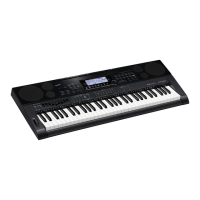How to find missing items from my new Casio CTK-7000?
- PpadillacrystalSep 12, 2025
Carefully check inside all of the packing materials to find the missing item from your Casio Electronic Keyboard.

How to find missing items from my new Casio CTK-7000?
Carefully check inside all of the packing materials to find the missing item from your Casio Electronic Keyboard.
| Number of Keys | 61 |
|---|---|
| Amplifier Output | 6W + 6W |
| Pedal Input | Yes |
| Headphone Jack | Yes |
| Polyphony | 48 |
| Display | LCD |
| USB Port | Yes |
| Sound Source | AHL |
| Mixer | Yes |
| Metronome | Yes |
| Other Functions | Registration Memory |
| Key Transpose | Yes |
| Tuning Control | Yes |
| Speakers | 2 x 12 cm |
| Inputs/Outputs | USB |
| Power Requirements | AC Adaptor |
| MIDI | Yes |
| Effects | Reverb, Chorus |
Procedure for selecting a single tone applied across the entire keyboard.
Explains playing two or three different tones simultaneously using layer and split.
Steps to select and play auto accompaniment patterns with chords.
Procedure to select effect types like reverb, chorus, and DSP.
Instructions for creating custom DSP effects by editing built-in presets.
Step-by-step guide on navigating and changing mixer settings.
Step-by-step guide to creating and saving custom tones from presets.
Detailed list of parameters for adjusting tone characteristics like attack, release, and vibrato.
Instructions for selecting and playing drawbar organ tones, including real-time adjustment.
Guide to editing existing drawbar organ tones and storing them as user tones.
Provides one-touch access to Auto Accompaniment, tone, and reverb for preset chord progressions.
Steps to create and save custom music presets by editing existing ones.
Guide to modifying preset chord progressions and saving them as user presets.
Detailed steps for saving current keyboard settings to registration memory.
Procedure for loading saved settings from registration memory.
Instructions for starting quick recording using a single button.
Guide on recording to the system track and individual tracks (01-16).
Explains how to re-record specific sections of a song to correct errors.
Instructions for playing back recorded songs, including playback controls.
Overview of song editing operations like clearing, copying, and renaming songs.
Introduction to editing individual events (note, pitch bend, etc.) within a song.
Guide on creating new rhythms by editing existing ones or from scratch.
Detailed steps for editing rhythms, including pattern and mixer settings.
Details on configuring part parameters for instruments within accompaniment patterns.
Overview of recording keyboard play, songs, and external input as audio files.
Procedure for playing back recorded audio files from a memory card.
Details tuning, touch response, pedal, bend range, arpeggiator, and filter settings.
Procedure for saving user data like rhythms, tones, and presets to a memory card.
Steps to load data from a memory card into Digital Keyboard memory.
Step-by-step guide for connecting the keyboard to a computer via USB.
Provides solutions for common symptoms and problems.
